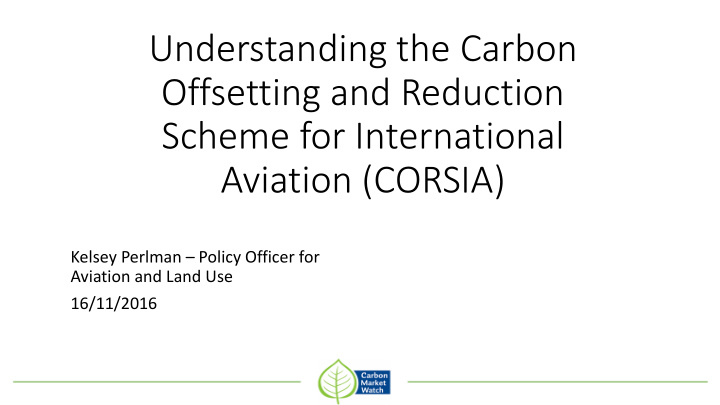



Understanding the Carbon Offsetting and Reduction Scheme for International Aviation (CORSIA) Kelsey Perlman – Policy Officer for Aviation and Land Use 16/11/2016
CORSIA is an offsetting scheme
Objective of the CORSIA • Inaction until 2020, some countries offset emissions above 2020 levels • The amount of CO2 being addressed = ¼ of total international traffic from 2021- 2035 • Inconsistent with 2 degree scenarios • Conditional on credit quality
How does it work? • Only international emissions from flights between two countries in the scheme are included. • Airlines multiply their annual emissions above 2020 levels x the growth of the industry to get an offsetting obligation • Offset providers apply to be eligible and are screened by quality criteria that has not yet been developed • Developing offset criteria: Multilateral process, many states have their own offsetting programmes
A market mechanism under construction Timeline: ● National policies for registry establishment - 2018 ● Operationalisation of the centralized ICAO registry - 1 January 2021 ● ICAO standards on Monitoring, reporting and verification (MRV) and emissions unit criteria (EUC) - 2018 before being translated into national policy. Transparency: ● Accessibility of information and possibility to input for civil society ● Of the CORSIA itself (registries, selection of eligible programmes)
Lessons from carbon markets: oversupply • Emission Trading Systems: All 17 emissions trading systems suffer from oversupply. • UNFCCC offsets: World Bank has shown demand for CERs between 2015 and 2020 is limited. Why is this so? • Policy makers (and industry) forecasting emissions tend to overestimate.
Lessons from UNFCCC: credit quality p.21: Decides that emissions units generated from mechanisms established under the UNFCCC and the Paris Agreement are eligible for use in CORSIA, provided that they align with decisions by the Council, with the technical contribution of CAEP, including on avoiding double counting and on eligible vintage and timeframe Until there is an ICAO standard on Emissions Unit Criteria (EUC), CDM projects like the Adani Mundra coal power project in India could be eligible.
Lessons from UNFCCC: centralized governance
Lessons from the UNFCCC: Recommendations • Transparency of the market and public participation are essential to the credibility of the mechanism • Negative/positive lists provide administrative simplicity for airline operators looking to avoid risky offset purchases • Eligibility of credits should be limited to UNFCCC credits screened by additional quality criteria • Strong central oversight is needed to avoid self enforcement which has led to the generation of fake credits in the past
The complex world of markets just got more complicated
What is required in the UNFCCC? • Avoiding double counting outside of NDCs: Offsets for the CORSIA will be coming from countries that now have climate targets and this needs to be reflected in accounting of NDCs (APA item 3) • Transparency of climate action: Yearly offset reports should be included in states communications to show that offsets used in the CORSIA do not impact a states’progress toward their NDC (APA item 5) • Long term progress towards 1.5: Processes looking at the long term goal of the PA must include all anthropogenic emissions to see where further action is needed (Facilitative Dialogue – APA item 3 , Global Stocktake – APA item 6 ) • Credibility of Markets: Market mechanisms must have rules to avoid double counting with targets outside of NDCs (CDM and Article 6)
Thank you! kelsey.perlman@carbonmarketwatch.org www.carbonmarketwatch.org @CarbonMrktWatch carbonmarketwatch
Recommend
More recommend